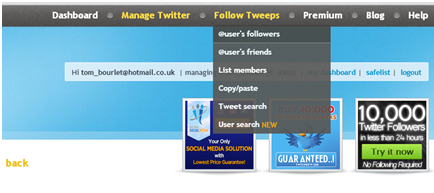One of the most successful ways to build an account on Twitter is through a follow/unfollow process to gain new followers. I do this once a day, usually in the morning, where I unfollow about 250 and follow 300. For this, I use Tweepi, which you can login via Twitter oauth. From the dashboard, you unfollow people via the ‘flush’ button:
Once the page opens up, make sure it is showing 40 per page (so as to save time). Start from the last page, so you are unfollowing people you followed the longest period of time ago. Click on the box for the top profile, go to the bottom of the page and hold CTRL & shift, while clicking on the box for the bottom profile. This will select all 40. You then press ‘unfollow’ as can be seen below:
Once you have unfollowed 250 profiles (make sure to check the numbers you are following on Twitter before you do this, so that you can properly monitor the real numbers, not what Tweepi says have been removed), you can then begin following profiles. To do this, you hover over ‘follow tweeps’ and then click on @user’s followers:
From here you will be following someone’s followers, therefore you need to pick a profile who you think would have potential customers as followers. For this reason, I have been going for UK based Twitter handles, with a decent following, but not so high so that they would be targeted by fake accounts (Stephen Fry etc). An example of a good Twitter handle for me to potentially follow (for a travel client) the followers of would be Thomas Cook, Lowcostholidays or any UK based travel agents, an airport Twitter handle or a travel guidance account.
Remember that if you are a new account (under 3-6 months) then you will want to follow/unfollow less than the amounts I mentioned, as Twitter watches much more closely.
One specific keyword search which I regularly follow is #journorequest, as this has gained a large amount of high quality links for clients. This is a hashtag usually used by journalists who are looking for case studies, of which you can highlight yourself as a representative of the company. This has helped me gain links from MSN-money, the Telegraph and a number of University websites.
I have found Twitter advertising to not be worthwhile as the cost per acquisition is ridiculously high, however I do hope to be proven wrong at some point in the future, however for now I wouldn’t recommend taking this path.
Twitter have now brought through keyword tracking, which basically recognises specific words in a tweet which sends signals of user interest and intention. You could potentially use this to target people looking for holidays (or whatever you are advertising) while targeting specific areas. On the other hand, I struggle to see the power of this over using Tweetdeck (which is free). As this is automated, it would take away some of the running cost of someone completing this job manually, however an intern can normally complete this job at a much lower cost per post. The paid for post also only places it on their feed, rather than a mention directly to the reader.
Tweetdeck
I monitor a number of keywords and messages on Twitter via Tweetdeck, an incredibly useful free tool, which can be used to find potential customers. By looking for a number of relevant terms, we can find people who have recently written a tweet about exactly what we are trying to sell, whether looking for advice or complaining that they need the product. This can be used as an extra channel for lead generation, however the task can be long and arduous.
Never use slang or unprofessional language, While you might feel it helps you to connect with the reader, many feel it appears unprofessional and can lose trust in the company. For this same reason, it is important there are no spelling mistakes. Obviously this doesn’t apply if the account is for a blog or a personal account.

